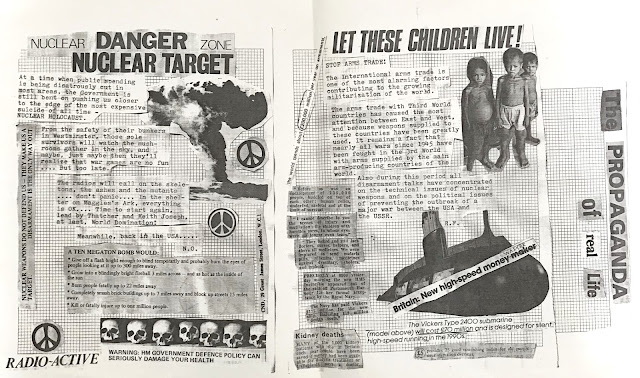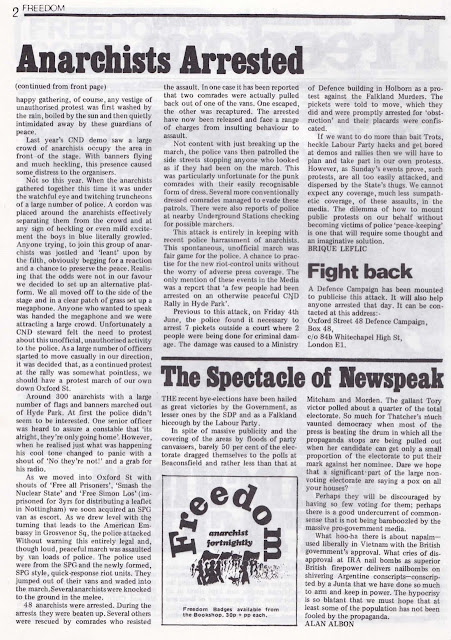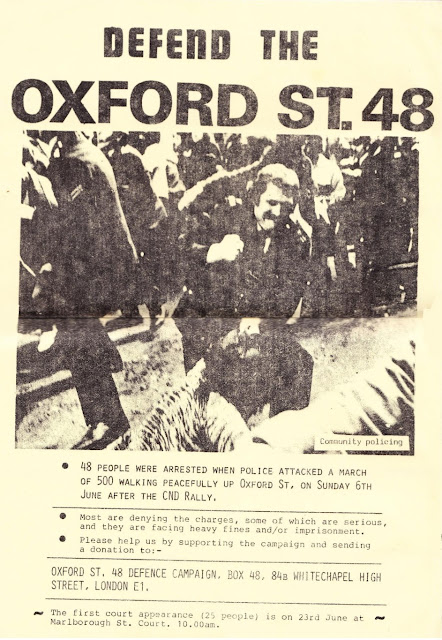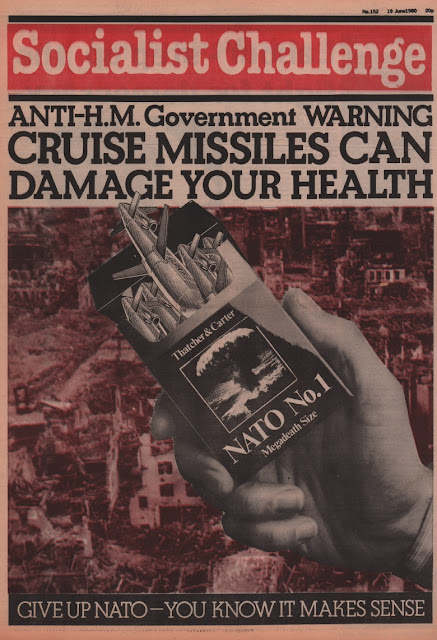 |
| Style Council on stage in Brockwell Park, May 1983 |
 |
| 'Let Europe Dance. Our Future in Nuclear-Free' |
 |
| Style Council on stage in Brockwell Park, May 1983 |
 |
| 'Let Europe Dance. Our Future in Nuclear-Free' |
Peter Kennard: Archive of Dissent at the Whitechapel Gallery is a retrospective of 50 years of radical image making.
 |
| 'blast open the continuum of history] - illustration for Guardian article on Walter Benjamin, 1990 |
Radical Photomontage
I've no doubt that it was through discussion of Kennard's work in the left press at this period that I first came across John Heartfield who of course was a big influence on him.
The juxtaposition of images and newspaper clippings was also a feature of punk/post punk sleeve design, such as The Pop Group's 'How much longer do we tolerate mass murder?' (1980)
Possibly my first print political intervention at this time (1980) was sticking up crude photocopied montages around my school (Luton Sixth Form) - 'The Propaganda of Real Life' - with me and my friend Robert F. Not sure how many people read them, but it acted like putting a spell out in the world to find like minded people. Off the back of this somebody invited us to a meeting in Sundon Park where a group of us teenagers set up Luton Peace Campaign, soon to become the Luton branch of the reborn CND.
 |
I am sure many other people were similarly inspired by Kennard, Heartfield and the DIY possibilities of photomontage at this time. Hopefully the Whitechapel exhibition will inspire some even now to pick up scissors and glue.
Peter Kennard: Archive of Dissent at the Whitechapel Gallery, 23 July 2024- 19 January 2025 (admission free)
On Sunday June 6th 1982, the Campaign for Nuclear Disarmament held a huge demonstration to coincide with a visit by US President Ronald Reagan. Up tp 250,000 people marched to London's Hyde Park, where the speakers included Labour MP Tony Benn and miners' leader Arthur Scargill. The recent Falklands war had shown up the weakness of the peace movement, which had failed to significantly mobilise against the war. This account of the demonstration was written in a text '1980 to 1984: anarchy on the CND demo':
"At Hyde Park it was the same as usual and anarchists who tried to heckle the speakers were kept miles away from the front of the stage by police. Some of us gathered behind the official platform setting up our free platform with a megaphone to discuss the Reagan visit, the Falklands war and any issue the people wished to raise. Many took advantage of this situation to air their views, as the official platfor was only open to invited speakers, not to anyone who might have something creative or new to suggest. A proposal was made that we move out of Hyde Park where we were wasting our time and take the issues to the London crowds in Oxford Street. This idea was greeted with enthusiasm. About 300 people gathered at the Speakers Corner end of Hyde Park and by now many of us were in defiant mood. Some began breaking across the road over to Oxford Street, there were no stewards this time. There was a lot of confusion with people trying to keep the group together and deciding what to do next. The group pushed on loudly down Oxford Street with more following behind. Fump! Hooray! Everyone cheered as someone let off fireworks and the traffic was blocked. It was some time before the vans started to arrive on the scene. As the police vans slowly pulled up in force those in the front decided to head down a side street to the american embassy it was too late, the police jumped from the vans and charged into the march. About 20 marchers made it into the side street and were able to escape including one who received a nasty gash on the forehead form a truncheon. However 48 were arrested".
An Oxford Street 48 Defence Campaign was set up to support those arrested, and Scottish punk band Political Asylum recorded a track 'Oxford Street 48':
The events were reported in 'Freedom' as 'Anarchists Attacked':
'Around 300 anarchists with a number of flags and banners marched out of Hyde Park. At first the police didn't seem to be interested. One senior officer was heard to assure a constable that 'its alright, they're only going home'. However, when he realised just what was happening his cool tone changed to panic with a shout of 'NO they're not!' and a grab for his radio.
As we moved into Oxford St with shouts of 'Free all Prisoners', 'Smash the Nuclear State' and 'Free Simon Los' (imprisoned for 3yrs for distributing a leaflet in Nottingham) we soon acquired an SPG van as escort. As we drew level with the turning that leads to the American Embassy in Grosvenor Sq, the police attacked Without warning this entirely legal and, though loud, peaceful march was assaulted by van loads of police. The police used were from the SPG and the newly formed, SPG style, quick-response riot units. They jumped out of their vans and waded into the march.
Several anarchists were knocked to the ground in the melee. 48 anarchists were arrested. During the arrests they were beaten up. Several others were rescued by comrades who resisted the assault. In one case it has been reported that two comrades were actually pulled back out of one of the vans. One escaped, the other was recaptured. The arrested have now been released and face a range of charges from insulting behaviour to assault.
Not content with just breaking up the march, the police vans then patrolled the side streets stopping anyone who looked as if they had been on the march. This was particularly unfortunate for the punk comrades with their easily recognisable form of dress. Several more conventionally dressed comrades managed to evade these patrols. There were also reports of police at nearby Underground Stations checking for possible marchers'.
 |
| (Freedom, 12 June 1982 - the address for the campaign at 84b Whitechapel High St was/is the Freedom bookshop) |
 |
| '48 people were arrested when police attacked a march of 500 walking peacefully up Oxford Street on Sunday 6th June after the CND rally. Most are denying the charges, some of which are serious'. (leaflet reproduced in Toxic Graffiti zine at the time)  (Militant, 11 June 1982)   (Socialist Worker, 12 June 1982 -wonder whether Morrissey got the title for The Smiths 'Barbarism begins at home' from this article? Though I have read that the demo title for that song was 'Fascism beings home' See also: Reagan visits London 1984 |
 |
| Peter Kennard's design for the flyer/poster |
The announcement of the deployment of a new generation of US nuclear weapons in Europe, coupled with increasing tension between NATO and the Soviet Union, led to a mass peace movement across the West in the early 1980s. In England the first major demonstration against these cruise missiles was called by the Labour Party on June 22 1980, during a brief period when the leadership of the Party were voicing opposition to nuclear weapons.
Around 25,000 people marched in the pouring rain from London's South Bank to Hyde Park. Speakers included veteran peace campaigner Fenner Brockway, soon to be Labour leader Michael Foot and the actor Susannah York who told the crowd, 'I refused to accept that 25,000 people here today are one fortieth of a megadeath. I am not a millionth of a megadeath. We are ourselves'.
The image of the megadeath and mass nuclear destruction haunted the nightmares of young people like myself getting involved in this new peace movement and recurs across popular culture in this period. In its report of the demo, Socialist Challenge noted that 'One of the most striking features of the demonstration was the high proportion of young people who turned out. Groups of friends carried home-made placards calling for an end to war: "Fall in against fallout", "Education not Missiles", "Wage War on Weapons", "Germ Warfare means Nightmare".
 |
| Socialist Challenge, 12 June 1980 |
 |
| Socialist Challenge front page for the demo - demanding 'Give up NATO', which was not the position of the Labour Party organisers |
 |
 |
| Luton Nuclear Disarmament Campaign banner makes its public debut |
 |
| Some kind of street theatre, mocking Government's 'civil defence' plans |
 |
| Rally at the end of demo - 'Cruise missiles make Newbury target No.1'. The speaker here was from the Luton group. Not sure who the folk singers were - anybody know? |
 |
| Report from Socialist Challenge, 25 September 1980 |
The massive October 1980 Campaign for Nuclear Disarmament 'Protest and Survive' demonstration in London represented the rebirth of the 'Ban the Bomb' movement that had been largely dormant since its previous high point in the 1960s. The reason for this revival was that nuclear war was once again seeming a real possibility as the Cold War began to hot up.
In 1979 Russian forces had entered Afghanistan in support of the beleaguered pro-soviet government. The ascendancy of the new right to power in Britain and the USA saw a cranking up of anti-Russian rhetoric from Thatcher and Reagan, soon to be followed up with the deployment of a new generation of nuclear missiles in Europe.
The British Government's publication of its 'Protect and Survive' booklet in May 1980 only made the nuclear nightmare more tangible, with its absurd advice for turning your home into a fall out shelter amidst nuclear war. This was parodied by EP Thompson in his 'Protest and Survive' pamphlet published by CND shortly afterwards.
 |
Photomontage artist Peter Kennard produced a memorable image of a skeleton reading the Government publication as well as designing the leaflet/poster for the demonstration set for 26th October 1980.
I was at sixth form and with a group of friends that year had set up Luton Peace Campaign (soon to be Luton Nuclear Disarmament Campaign) which quickly grew to having over 100 members. Similar groups were springing up all over the country. We organised a couple of coach loads to go to London for the march and were amazed at the turn out, variously estimated as between 50,000 (the police) and 100,000 (Socialist Organiser). For the first time I had a real sense of how the efforts of small groups of people meeting in pubs and kitchens could coalesce into a mass social movement.
As reported in the Daily Mirror (27 October 2020):
'Britain’s ban the bomb movement was reborn yesterday with a massive show of strength. More than 60,000 demonstrators jammed London streets for the biggest nuclear disarmament rally in 17 years. The day started with a huge inflatable mushroom ‘cloud’ being floated above Hyde Park as the demonstrators gathered under a sea of banners. The protesters then brought traffic to a standstill as they marched to Trafalgar Square…
There were hippies, punk rockers, skinheads and supporters of all ages. A girl on rollerskates joined the protest. So did a band of Buddhist monks. 12 people were arrested and charged with minor offences such as threatening behaviour and obstruction. Scuffles broke out as one group tried to march down Whitehall towards Downing Street and Parliament. But a line of policeman headed them off and the rest of the demonstration was peaceful'.
 |
| The mushroom cloud inflatable in Hyde Park (from 'Socialist Organiser', 8 Nov. 1980) |
 |
| Luton Nuclear Disarmament Campaign banner on demo |
 |
| 'Heavy armour, little brain - died out' - dinosaur on demo |
The speakers included MPs Tony Benn and Neil Kinnock, actor Susannah York, EP Thompson and Bruce Kent of CND. I was excited that The Pop Group and Killing Joke were playing in Trafalgar Square at the end of the rally, though it was one of those occasions when the crowd was so big (and the PA so small) that you had to be up front to really experience the music - and I wasn't. Luckily I got to see The Pop Group at their peak earlier that year at the Beat the Blues Festival at Alexandra Palace.
 |
| The Pop Group on stage in Trafalgar Square |
 |
| Another Peter Kennard design |
 |
| A poster from Liverpool advertising the demo |